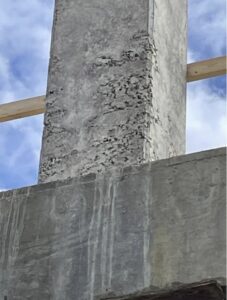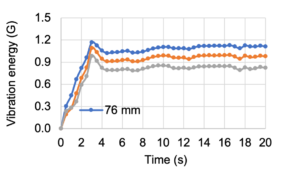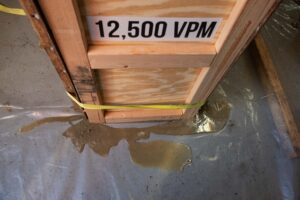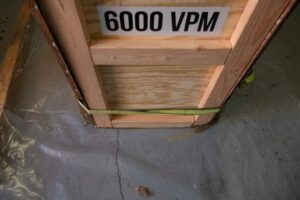
Good Vibrations
By Paul Jaworski
Concrete Construction Construction MaterialsResearching vibration energy transfers to help track better vibration field practices.
Members of the American Concrete Institute (ACI) are working to bring more understanding about the use of vibration energy to the industry to improve outcomes for contractors.
At the just-concluded ACI Fall Convention, promising research was presented to the Consolidation Technical Committee that can be used to capture and gather data for the purpose of machine learning during the vibration of concrete pavements. Members of the committee have been busy for the past four years gathering and testing quality control methods to offer more predictable outcomes in vibrating various concrete mixtures across several construction applications.
With ACI 309 Consolidation Guidance document being re-written, the members have been engaged in producing a new document that will offer contractors a better understanding of vibration energy and how to limit the amount of surface damage from over-vibration. Since the concrete industry is focused on carbon-neutral initiatives, which includes producing concrete mixtures that use Type 1L cement, the committee has stepped up the urgency to update its guidance document.
Vibration research for the document has been concentrating on the challenges of placing pumpable mixtures without separating available mix water and a more advanced testing platform targeted at machine-learning methods in placing concrete pavement mixtures.
The effort has been focused on construction case studies using controlled frequency vibration (CFV) that applies the same vibration energy to the concrete, and more importantly maintains a frequency, despite any concrete load changes. The method has led to specifications that set maximum allowable limits to vibration frequency in pavements to limit any concrete distresses from frequency over-vibration. New limits to vibration frequency will result in a maximum frequency for commercial applications, especially pumpables.
In 2021, Iowa State University released a study of the effects of vibration on mixtures by looking at vibration energy transfers to clinically verify what the field studies have been empirically telling us about frequency over-vibration: the quality of concrete surfaces is usually compromised with vibrator frequency.
Iowa State researchers used a fixed frequency and output of force during vibration that can be tracked through the concrete. This revealed important factors that outline the behaviour of frequency and the material separation that it causes (see Chart on Page 34). The energy transfers reveal how to meet consolidation standards in concrete mixtures while limiting the issues that come with over-vibration of low-viscosity mixtures.
In a sustainable model, vibration energy is the easiest piece of the puzzle to control. The researcher simply chooses a fixed vibrator frequency that matches the workability of concrete at pre-construction trials during mock-ups.
In both pavements and pumpable mixtures, just the frequency control and reduction in frequencies has shown a marked improvement in limiting the damage that high frequency does to most concrete mixtures. Once the vibrator is set at a frequency, the control of vibration process turns to evaluating the variability challenges in the workability associated with concrete production.
To set vibration frequency and move towards machine learning, a method of controls includes reading changes in concrete workability and understanding how to adjust vibration to those changes.
The ability to measure vibration energy in fresh concrete is paramount to limiting the damage that is continually done by over-vibration in many concrete placement applications. For a century, the vibration process has tried to match applied energy with a slump cone test. The slump cone test is seldom used in measuring the concrete workability of pavement applications, however.
The initial study of using vibration energy transfers on mixtures showed that the slump cone test was also not an indicator for any commercial concrete mixtures. In the Iowa State study, energy transfers showed that the measure of static yield in the slump cone test did not represent what happens when vibration energy is applied to the concrete. A better view of vibration’s effects comes with capturing the dynamic yield of concrete through analyzing vibration energy transfers.
The ability to show dynamic yield values through energy transfers has told the committee that all slump values are not equal. Two different concrete mixtures can have the same slump value but may have arrived at that slump through different amounts of water-reducing agents. Although the samples are the exact same slump as indicated by the slump cone test, they react differently when vibration energy is introduced.
This revelation allows for a much better understanding of several conditions of over-vibration by vibrator frequency by evaluating vibration energy against what the concrete resistance (dampening effect) before widespread material separation occurs.
Once you go past concrete’s threshold, you begin to relocate water away from the vibrating head to the surface of pavements, or to the form surfaces in the case of placing pumpable mixes. In concrete pavements, the paving machine will eventually have vibration energy transfer sensors that will aid in the machine learning of concrete paving machines by tracking and logging the vibration energy transfer data. The information from the transfer data will be sent to the paver’s network controller to allow more controls on the paving process.
The paver already uses a vibration monitoring system to control a vibrator frequency range, but the learning with energy transfers can look at the effects of static head, change in workability and frequency adjustments to the paver’s forward travel speed.
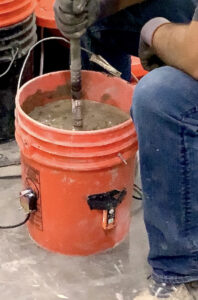
The “Quake” has been developed by Oklahoma State University to help understand the behavior of vibration energy. (Photo courtesy of Minnich Manufacturing)
Tracking energy transfers can also be a big help in analyzing concrete samples from the laboratory, batching, transport and the condition of the concrete workability as it enters that paver prior to vibration.
How does all this help contractors place pumpable mixtures?
The research, case studies and field effort to find better vibration solutions through the development of quality control tools and methods to meet the always-changing materials in mix designs, is a matter of developing tools for our biggest priority—constructability. The committee has incorporated guidance maximum limits when vibrating pumpable and near flowable mixtures above the measured five-inch slump value.
The most adopted frequency during field trials has been the 8,000 vpm range to immediately bring down the amount of water separation. In the new Consolidation Guidance Document, methods will be outlined for determining a compatible frequency for the trial mixture at mock-ups. Choosing a frequency that offers the least disturbance for the amounts of available water in the mixture is the first step, and is very helpful in controlling concrete surface issues.
Vibration has always been misunderstood because research and science has not been exposed to users, but controls are important to sustainable concrete placement practices. The best way to control concrete issues is to accurately measure fixed frequency vibration and variability in concrete production. With the eight different ongoing research studies involving vibration’s effects on concrete, field controls through analyzing energy transfers will soon become reality.
Paul Jaworski is the product manager at Minnich Manufacturing, Inc. He has more than 40 years of experience in concrete vibration and consolidation.

